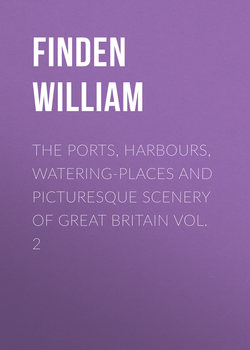Читать книгу The Ports, Harbours, Watering-places and Picturesque Scenery of Great Britain Vol. 2 - Finden William - Страница 4
ST. NICHOLAS' CHURCH AND ST. GEORGE'S BASIN, LIVERPOOL
Оглавление"Here have the wild deer bounded, – here the trees
Waved, a wide-spreading forest, in the breeze!
Then came the woodman's axe, – the forest fell, —
The shrine arose, and peal'd the chapel bell; —
The crowd of pilgrims and the sound of prayer
Disturbed the woodland savage in his lair…
What hear we now! – what see we in the gale!
The city's shout, – the far-expanding sail, —
The crowded Mart, – the tramp of busy feet —
And wheels that shake the densely-peopled street."
St. Nicholas, or the Old Church, is supposed to stand upon the site of an ancient chapel built about the time of the Conquest. But whether this be correct or not, there is at least evidence to prove that, in 1361, license for burial here was granted by the Bishop of Lichfield. It was endowed by Queen Elizabeth with a small sum, under five pounds, to be paid annually out of the chantry rents to the minister; and another sum, between five and six pounds, as a yearly grant to the schoolmaster. In the olden time a statue of the patron, St. Nicholas, erected in the churchyard, was much frequented by mariners, who believed that an offering made to the saint would conciliate the winds in their favour, and secure a prosperous voyage. Time, however, put an end to this confederacy between the saint and seamen. St. Nicholas was dethroned; and for a time the winds "blew as if they would have cracked their cheeks" at the downfall of one who had so long laid them under arrest. But at length a better knowledge of the compass and the coast made the seaman ample compensation for the loss of his ghostly patron, and showed him that a skilful mariner and a stout bark are better securities against storm and tempest than any saint in the calendar.
In 1774 this church was rebuilt, – "The old roof, walls, and Gothic pillars, the old blue ceiling, black and white clouds, golden sun, moon, and stars, painted and gilt thereon," were removed, and the re-edification completed, under the direction of Joseph Brooks, Esq. In 1810 this church was the scene of a dreadful catastrophe; the steeple suddenly gave way as the children of the charity-school were entering the church. It fell upon the body of the building, and twenty-four lives were sacrificed, seventeen of which were girls belonging to the school. Many others were severely wounded. The accident was attributed to the weakness of an old arch upon which a modern spire had been erected. The spire was subsequently restored by Mr. Harrison, of Chester, with a degree of taste and execution which does him credit. It consists of an ornamented Gothic tower, surmounted by an open lantern, with an air of great lightness and elegance, and forming a very striking feature among the many architectural objects – civil and ecclesiastical – by which it is surrounded. The height of the tower is one hundred and twenty feet, and that of the lantern sixty; so that together the steeple has an elevation of not less than one hundred and eighty feet. During the night the clock opposite the river is illuminated, so that it may serve as a landmark to assure the mariner that St. Nicholas is still on the watch for his safety, as in the good olden time.
St. George's Dock, from which the view of the Church is taken, was constructed according to an act of parliament obtained in 1762, and completed at an expenditure of twenty-one thousand pounds. It is two hundred and sixty-four yards in length, one hundred in breadth, and lined on the east side by a row of very large warehouses, with footpaths under the piazzas. Extending along both sides are sheds for merchandise; and on the pier-head, at the west side of the dock, are the public baths. The latter, comprised in a large building of plain but classical design and execution, were erected by the corporation at an expense of thirty-six thousand pounds, and opened to the public in the month of June, 1829. Nothing could be better adapted to its purpose than this great public edifice, in which the twofold recommendation of ornament and utility are happily combined. The water is constantly flowing through the baths in a fresh current; being supplied from the river at high-tide, filtered, and contained in a reservoir of eight hundred tons under the centre of the building. Private, cold, shower, warm, tepid, medicated, and vapour baths are to be had at all hours; and from the excellent manner in which every department is arranged and conducted, the inhabitants possess in this establishment one of the great means of promoting health and averting disease.
